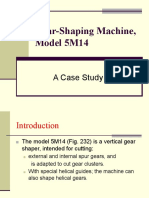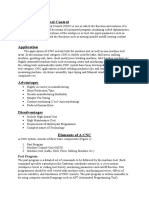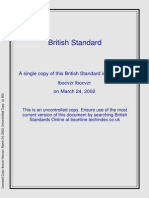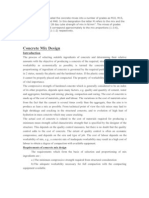Chuck Pressure PDF
Chuck Pressure PDF
Uploaded by
iggie4068Copyright:
Available Formats
Chuck Pressure PDF
Chuck Pressure PDF
Uploaded by
iggie4068Original Title
Copyright
Available Formats
Share this document
Did you find this document useful?
Is this content inappropriate?
Copyright:
Available Formats
Chuck Pressure PDF
Chuck Pressure PDF
Uploaded by
iggie4068Copyright:
Available Formats
General information and guidelines
Power-operated clamping devices
To ensure safe operation of power-operated clamping devices, particularly of chucks, on heavy-duty lathes with
high speeds certain criteria must be observed:
1. Whenmounting the power chuck and the clamping cylinder on the lathe, the following safety requirements
must be met:
1.1 The machine spindle may only start when the clamping pressure has been built up in the actuating
cylinder and the clamping has been carried out in the permissible working area.
1.2 Unclamping may only be possible when the machine spindle has completely stopped.
1.3 In case of a clamping energy failure, the workpiece must be firmly clamped until the spindle is completely
stopped. (The Rhm safety cylindersmeet this requirement.)
1.4 In case of a current failure and upon return of the current supply the actual control position may not
be changed.
1.5 In case of a clamping energy failure the machine spindle must be stopped by a signal.
3. After havingmounted the chuck and before starting the operation, the function of the chuck must be checked.
Two important points are:
3.1 Clamping force
The clamping force (15%) stated for the clamping devicemust be reached atmax. actuating force/pressure.
3.2 Stroke control
A safety range must be provided for the stroke of the clamping piston in the front and rear end position. The
machine spindle may only start after the clamping piston has crossed the safety range.
Only limit switches meeting the requirements for safety limit switches in accordance with VDE 0113/12.73
section 7.1.3 may be used for monitoring the clamping path.
4. If themax. speed of the lathe exceeds themax. speed of the clamping device or clamping cylinder, the
machine must be equipped with a speed limitation device.
5. When the clamping device has been changed, the stroke control must be adjusted to the new condition.
6. When calculating the required clamping force formachining a workpiece, the centrifugal force of the clamping
jaws must be considered.
7. A reliable operation of the power chuck can only be guaranteed when themaintenance instructions contained
in the instruction manual are precisely followed.
In particular the following points must be observed:
7.1 For the lubrication only the lubricants recommended in the operation manual shall be used. (An unsuitable
lubricant can reduce the clamping force by more than 50%).
7.2 The lubricationmust reach all surfaces to be lubricated.
(At the narrow fits of themounting parts a high pressure is required for pressing-in the lubricant. For those
purpose a pressure gun must be used).
7.3 In order to distribute the grease evenly, actuate the clamping piston several times to its end positions, repeat
the lubrication and then check the clamping force.
6223
Power-operated
clamping devices
2. The safety instructions given in the respective operation manual must be precisely followed.
General information and guidelines
Power-operated clamping devices
8. Before restarting a serial machining operation and in between the maintenance intervals the clamping force
should be checked by means of a load cell. Only regular checks ensure optimum reliability.
9. It is recommended to move the clamping piston several times to its end positions after 500 clamping strokes at
the latest. (In this way any lubricant pushed away will be returned to the pressure surfaces. The pressure force is
thus maintained for a longer period of time.)
10. When using special clamping jawsthe following instructions must be observed:
10.1 The clamping jaws should be designed in such a way that their weight and height is as low as possible.
The clamping point should as possible be as close to the frontside of the chuck. (Clamping points at a
larger distancemay cause a higher surface pressure in the jaw guiding mechanism and may thus reduce the
clamping force considerably.)
10.2 In case the special jaws are for constructional reasons wider and/or higher than the step jaws assigned
to the clamping device, the resulting higher centrifugal forcesmust be considered when calculating the
required clamping pressure and the rated speed.
For calculating the rated speed for a certainmachining task the following formula is to be applied:
Power-operated
clamping devices
nmax. =
F spo -- F spz
.
m . rc . a
30
Fspo = initial clamping force with the chuck at standstill (N)
F spz = required clamping force with the chuck at standstill for a certain machining task (N)
n max. = max. admissible speed (min 1)
m = mass of the entire jaw unit (kg) (base and top jaw)
rc = center of gravity radius of the entire jaw unit (m)
a = number of jaws
10.3 Welded jaws should not be used. If required, the welding seamsmust be checked as to their centrifugal
and clamping force capacity.
10.4 Themounting screwsmust be arranged in such a way that the highest possible useful moment is reached.
11. Themax. speedmay only be used atmax. applied actuating force and with properly functioning chucks.
12. In case of high speeds the chucks may only be used below a protective hood with sufficiently large dimensions.
13. For power chucks with a jaw quick-change feature internal to the chuck a safety device is required which
revents the machine spindle from rotating when the clamping jaws are released.
14. After a collision the clamping devicemust be checked for fissures before being used again.
15. Worn or damaged jaw fixing bolts must be replaced. Only use bolts of quality 12.9.
6224
Determining the required gripping force of a power chuck
Power-operated clamping devices
Determining the required gripping force of a power chuck and the corresponding operating power
I) Calculating the gripping force Fspz (without considering the effects of angular speed) required for the job
(machining operation).
II) Determining the chucks initial gripping force Fspo with spindle stationary (taking into account the
centrifugal forces of the jaws).
III) Determining the operating power required to provide the initial gripping force Fspo.
Definition of gripping force
Progress in machining techniques has made it necessary for safety reasons not only to determine the necessary
gripping force but also to know and consider its change with increasing angular speed.
The forces and moments generated by the machining operation must be properly absorbed and transmitted by
the chuck. The chuck accomplishes this task mainly by producing a gripping force:
This gripping force is the arithmetic sum of the radial forces exerted on the workpiece by the jaws. The initial
gripping force Fspo produced when the chuck is stationary can be measured at any time and is therefore controllable. (Denoted by total gripping force in the gripping force / operating power diagrams).
In most cases it is sufficient in practice to use a simplified formula containing the fundamental determining factors
(crude determination).
Fs
= Main cutting force on radially applied tool
FsBo = Cutting force on axially applied tool (drill)
Fvax = Feeding force on axially applied tool
Fspz = Required total gripping force (without considering
the effects of angular speed
Fc
= Centrifugal force of the jaws
= Loss of gripping force (see gripping force/speed
diagram of each chuck Typee
Fspo = (Total) initial gripping force with the chuck stationary
Forces and moments acting at the machining and clamping points.
lz
= Distance betwwen machining and clamping points
dz
= Machining diameter
dsp
= Chucking diameter
lsp
= Chucking length
6225
Power-operated
clamping devices
The figures given in the catalogue refer only to chucks that are fully and correctly lubricated and in a properly
serviced condition. Many factors act on the clamping point during any machining operation. A precise specification
of these factors in the form of universally applicable tables is not possible in this context.
Determining the required gripping force of a power chuck
Power-operated clamping devices
A Turning
I) Calculating the required gripping force Fspz
The gripping force required depends on the Typee of work to be performed.
The cutting force on the turning tool has three basic components:
Main cutting force Fs - feeding force Fv - passive force (static force) Fp.
During turning, the feeding force Fv and the passive force (static force) Fp are mainly absorbed by the jaw faces in
contact with the seated workpiece. The remaining main cutting force produces a moment (Fs x dz/2) which must be
absorbed by the chuck and transmitted by friction at the clamping point.
The moment produced by the main cutting force during turning determines the gripping force required:
F spz =
Fs . S z
sp
where:
Fspz = gripping force required for a specific job with the
chuck stationary
Fs
= main cutting force
F . Sz
F spz = s
sp
dz = machining diameter
chucking ratio
Power-operated
clamping devices
dsp
sp
Sz
(1)
dz
d sp
dz
d sp
chucking
= cucking coefficient (friction between jaw and workpiece)
F
= safety factor s
= s . t . kc
The feeding force and passive components, Fv and Fp, are not included in this formula. If necessary for extreme
conditions, they are included in the safety factor Sz.
The main cutting force Fs is calculated from feed, depth of cut and material.
where:
s =
feed, mm/rev.
t =
depth of cut, mm
kc = specific cutting force, kN/mm2
Fs
(2)
= s . t . kc
The product s x t (feed.depth of cut) =chip cross-section(cross sectional area of cut) can be obtained from Table 1.
Determining the chip cross section [mm2] Table 1
Feed (mm)
Depth of cut t (mm)
2
0,16
0,20
0,25
0,32
0,40
0,50
0,63
0,80
1,0
1,25
1,60
0,64
0,8
1,0
1,26
1,6
2,0
2,5
3,2
0,75
0,96
1,2
1,5
1,89
2,4
3,0
3,75
4,8
10
12
0,8
1,0
1,28
1,6
2,0
2,52
3,2
4,0
5,0
6,4
0,8
1,0
1,25
1,6
2,0
2,5
3,15
4,0
5,0
6,25
8,0
0,96
1,2
1,5
1,96
2,4
3,0
3,78
4,8
6,0
7,5
9,6
1,12
1,4
1,75
2,24
2,8
3,5
4,41
5,6
7,0
8,75
11,2
1,28
1,6
2,0
2,56
3,2
4,0
5,04
6,4
8,0
10,0
12,8
1,44
1,8
2,25
2,88
3,6
4,5
5,67
7,2
9,0
11,25
14,4
1,6
2,0
2,5
3,2
4,0
5,0
6,3
8,0
10,0
12,5
16,0
1,92
2,4
3,0
3,84
4,8
6,0
7,56
9,6
12,0
15,0
19,2
The specific cutting force kc as a function of feed can be obtained from Table 2.
6226
Determining the required gripping force of a power chuck
Power-operated clamping devices
Specific cutting force kc [kN/mm2] Table 2
Specific cutting force kc at feed s and a setting angle of 45o
St 42
St 50
St 60
C 45
sino 0,50
0,52
0,62
0,67
C 60
0,77
St 70
0,72
18 CrNi 6
42 CrMo 4
0,63
0,73
16 MnCr 5
Mn, CrNi
Mn-austentic st.
St 42
St 42
St 42
St 42
Cast bronze
Gunmetal
Brass
Cast alumin.
0,77
0,85-1,00
Steels
Cast iron
materials
NEferrous
metals
The chucking ratio
Feed s [mm]
Strength
B
kN/mm2
Material
0,16
0,25
0,4
0,63
1,0
1,6
2,60
3,50
2,40
3,10
2,80
2,20
2,75
2,60
2,05
2,45
2,40
1,90
2,15
2,20
1,80
1,95
2,05
3,80
3,30
2,90
2,50
2,20
4,35
3,90
3,45
3,10
2,75
2,45
3,75
3,70
5,40
2,30
2,55
1,50
2,05
2,55
1,10
1,20
1,10
3,30
3,40
4,90
2,10
2,35
1,35
1,80
2,35
1,00
1,10
1,00
2,95
3,10
4,40
1,95
2,20
1,20
1,60
2,20
0,90
1,00
0,90
2,60
2,80
4,00
1,80
2,05
1,10
1,45
2,05
0,80
0,90
0,80
2,30
2,55
3,60
1,70
1,90
1,00
1,30
1,90
0,70
0,80
0,70
2,05
2,35
3,30
1,60
1,80
0,90
1,15
1,80
0,65
0,75
0,65
3,05
4,35
0,30-0,50
0,50-0,70
HB 2,00
HB 2,00-2,50
HB 0,80-1,20
0,30-0,422,60
dz
can either be determined from the specified working conditions or obtaines from Table 3.
dsp
Chucking ratio Table 3
Feed- dsp (mm)
40
60
80
20
40
60
80
100
150
200
250
300
350
400
500
600
700
800
1,0
0,5
0,33
0,25
0,2
0,13
2,0
1,0
0,67
0,5
0,4
0,27
0,2
0,16
3,0
1,5
1,0
0,75
0,6
0,4
0,3
0,24
0,2
0,17
4,0
2,0
1,3
1,0
0,8
0,53
0,4
0,32
0,27
0,23
0,2
0,16
100
150
200
250
300
350
400
500
600
700
800
2,5
1,7
1,3
1,0
0,67
0,5
0,4
033
0,29
0,25
0,2
0,17
3,8
2,5
1,9
1,5
1,0
0,75
0,6
0,5
0,43
0,38
0,3
0,25
0,21
0,19
3,3
2,5
2,0
1,3
1,0
0,8
0,67
0,57
0,5
0,4
0,33
0,29
0,25
4,2
3,1
2,5
1,7
1,3
1,0
0,83
0,72
0,62
0,5
0,42
0,36
0,31
3,8
3,0
2,0
1,5
1,2
1,0
0,86
0,75
0,6
0,5
0,43
0,37
4,4
3,5
1,3
1,8
1,4
1,2
1,0
0,87
0,7
0,58
0,5
0,44
4,0
2,7
2,0
1,6
1,3
1,1
1,0
0,8
0,67
0,57
0,5
3,3
2,5
2,0
1,7
1,4
1,3
1,0
0,83
0,71
0,62
4,0
3,0
2,4
2,0
1,7
1,5
1,2
1,0
0,86
0,75
3,5
2,8
2,3
2,0
1,8
1,4
1,2
1,0
0,87
4,0
3,2
2,7
2,3
2,0
1,6
1,3
1,1
1,0
The chucking coefficient sp accounts for the friction existing between the gripping surface of the jaws and the workpiece in the zone of contact.
It is influenced by
- the pattern of the gripping surfaces of the jaws
- the surface quality of the workpiece
- the material.
The chucking coefficient can be obtained from Table 4.
Note:
Forces aremore efficiently transmitted by a snug fit than by edge or saddle-Typee seats.
Chucking coefficient sp for steel parts Table 4
smooth
Gripping surface of jaws
Siamond style
Serrated
smooth machine finish ground
0,07
0,12
0,20
rough to medium machine finish
0,10
0,20
0,35
unmachined
0,15
0,30
0,45
Surface workpiece
Corrections:
AI, alloy
= 0,95
Brass
= 0,90
Gray cast iron = 0,80
6227
Power-operated
clamping devices
Depth of cut- dz [mm]
20
Determining the required gripping force of a power chuck
Power-operated clamping devices
Safety factor Sz
The magnitude of the safety factor Sz depends on the degree of accuracy with which the influencing parameters,
such as load, chucking coefficient etc., can be determined and on the degree of safety required.
It should be > 2 wherever possible.
=
Safety factor Sz (approximate)
Table 5
Safety factor Sz
Influencing parameters
New chucks
Older chucks
serviced regularly
a) overhung chucking lz dsp
b) no radial support from tailstock
c) tool applied radially
d) no axial seating of workpiece against jaws
e) ratio: chucking length to distance between
cutting and clamping points
lz 3
Power-operated
clamping devices
lz 3 6
> 2.0
=
> 2.4
=
> 4.0*
=
> 4.8*
=
* Lower safety factors can be applied if the workpiece is supported in the tailstock or axially seated against the jaws.
Superimpositions of alternating forces are neglected because their influence is very small in comparison with the
total gripping force required.
The safety factors so determined are applicable if the following requirements are met:
Chuck in perfect condition, no damage, adequately lubricated (operating instructions followed to the letter).
No allowance has been made for the following loads acting on the chuck:
a) Unbalanced forces and moments produced by unsymmetrical workpieces
b) Weight of workpiece
For a precise calculation of the gripping force required for a given
job, use VDI Recommendation 3106. Available from:
Beuth-Verlag GmbH, Kamekestrae 8, D-50672 Kln, Germany.
II)
At high speeds, the gripping force of the rotating lathe chuck is greatly influenced by the centrifugal forces of
the jaws. These forces must be taken into account when determining the initial gripping
force Fspo
The applicable formula is:
FSPO = SSP x (FSPZ FC)
The + sign applies to external gripping.
The - sign applies to internal gripping.
6228
Determining the required gripping force of a power chuck
Power-operated clamping devices
Where:
Fc = experimentally determined total centrifugal force of the chuck jaws obtained from the gripping forcespeed
diagram. The gripping force curves refer to the hard, stepped jaws of the chuck.
Ssp = safety factor for the initial gripping force in accordance with VDI Recommendation 3106 1,5
If extremely heavy top jaws (special jaws) are used, the centrifugal forces Fc can be calculated using
VDI Recommendation 3106.
III)
The operating power bears a given relationship to the total gripping force, depending on the Typee of chuck
employed. The values for the operating power can be obtained from the gripping force/operating power diagram.
In special cases where the centrifugal forces of the jaws are very high in comparison with the initial
gripping force and power chucks with standard top jaws cannot be used, certain operations can be done
with aluminium top jaws of special strength.
Calculation (example)
Having:
1. Workpiece and machining data:
Material
Chucking diameter:
dsp
(roughed)
Machining diameter:
dz
Feed:
s
Depth of cut:
t
Distance cutting/clamp. points: lz
Speed:
n
= C 45
= 60 mm
Power-operated
clamping devices
= 20 mm
= 0,5 mm
= 5 mm
= 50 mm
= 3000 min-1
2. Chuck data:
KFD 200 power chuck
Jaws with diamond style gripping surface Condition of chuck: new (no special influencing parameters)
External gripping with UB-538-04 top jaws at mid-position of gripping range.
Find:
1) Required gripping force
Fspz
total gripping force required (without the effect of angular speed
2) Initial gripping force
Fspo
(total) initial gripping force with the chuck stationary
3) Operating power
6229
Determining the required gripping force of a power chuck
Power-operated clamping devices
Solution
1) Main cutting force
(Formula 2)
s t
= from Table 1
kc
= from Table 2
Fs
Fspz
2) Required gripping force
(Formula 1)
= s t kc
= 0,5 5 2,50 = 6,25 kN
Fs Sz
dz
=
.
sp
dsp
=
6,25 kN 2,0 0,33
0,20
Safety factor Sz
Chucking coeff. sp
21,00 kN
= from Table 5
= from Table 4
d
Chucking ratio z
dsp
= from Table 3
Gripping force/speed diagram for KFD 3-jaw chucks
lower curve:
max. centrifugal
force of top jaw
upper curve:
min. centrifugal
force of top jaw
KFD 315
180
KFD 315
160
140
Total gripping force kN
Power-operated
clamping devices
3) Obtain the loss of the gripping force from the gripping force speed diagram for KFD 200.
At a speed of 3000 rpm: Fc = 18 kN. See diagram below.
4) Initial gripping force Fspo = Ssp (Fspz + Fc) (Formula 3) = 1,5 (21 kN + 18 kN) = 58,50 kN
Ssp determined in accordance with VDI Recommendation 3106 Fc obtained from diagram below
5) Obtain operating power from gripping force/operating power diagram for KFD 200. For a gripping force
of 58,50 kN the operating power is ~ 29,00 kN (next page)
Shallow design
KFD 250
120
100
80
60
KFD 200
Loss of gripping force = Fc (~ 18 kN)
KFD 160
40
20
KFD 130
1000
2000
3000
Speed rpm
6230
4000
5000
Determining the required gripping force of a power chuck
Power-operated clamping devices
Gripping force/operating power diagram KFD 3-jaw chuck
Chuck size
Total gripping force kN
100
150
200
250
250
300
630/800
100
500
150
100
400
30
200
150
40
50
200
60
50
250
70
250
80
100
300
90
100
150
110
120
130
190
315
50
100
140
250
50
200
90
50
160
70
35
130
10
20
30
40
50
60
70
80
90
100
Operating power kN
I)
The gripping force required is determined by the Typee of work to be performed. The calculation described below
applies to freely chucked work, i. e. workpieces which are not axially seated against the jaws. In this situation
the components FsBo (cutting force) and Fvax (feeding force) acting on the workpiece give the resultant FR to
determine the gripping force.
The cutting force FsBo
can be calculated from
FsBo = s t kc
(4)
where:
s = feed, mm/rev.
drill diameter
t = depth of cut, mm =
2
kc = specific cutting force kN/mm2
Feeding force Fvax
Table 6
Feeding force for drilling in solid material using a twist drill
The feeding force Fvax bears a given relationship to thecutting force
and can be directly obtained from Table 6.
40
25
m)
16
(m
10
ill
Dr
6,3
m)
(m
1
(m
te
dia
r d1
4,0
2,5
1,6
0,80
1,25
2,0
3,15
5,0
8,0
12,5
20
31,5 50
Cutting force FsBO [kN]
80
6211
6231
Power-operated
clamping devices
B. Drilling
> 120o)
1. Drilling in solid material (Top lip twist drill, point angle =
Determining the required gripping force of a power chuck
Power-operated clamping devices
The two components FsBo and Fvax give the resultant force FR
FR =
FSBo2 + Fvax2
The amount of the resultant force FR can be obtained directly from Table 7.
Intermediate values will have to be determined by interpolation.
Power-operated
clamping devices
Cutting force FsBo [kN]
Resultant force FR KN
Table 7
50
45
40
35
30
25
20
15
10
9,0
8,0
7,0
6,0
5,0
4,5
4,0
3,5
3,0
2,5
2,0
1,8
1,6
1,4
1,2
1,0
0,8
FSBo
FR
Fvax
5,8
2,0
1,8
1,7
1,6
1,4
2,3
2,1
2,0
1,8
1,7
1,6
2,6
2,4
2,3
2,1
2,0
1,9
1,8
1,2
1,4
1,6
3,1
2,7
2,5
2,4
2,3
2,2
2,1
2,0
3,2
2,8
2,7
2,6
2,4
2,3
2,2
2,2
1,8
2,0
4,3
3,9
3,5
3,2
3,1
3,0
2,9
2,8
2,5
5,4
5,0
4,6
4,2
3,9
3,6
3,5
3,4
3,0
6,9
6,1
5,7
5,3
4,9
4,6
4,3
4,0
3,5
8,1
7,2
6,4
6,0
5,7
5,3
5,0
4,7
4,0
10,3
9,4
8,6
7,8
7,0
6,7
6,4
6,1
5,8
8,3
7,5
6,7
6,4
6,0
5,7
5,4
5,1
4,5
5,0
16,2
11,7
10,8
10,0
9,2
8,5
7,8
7,5
7,2
6,0
16,6
11,2
11,4
10,6
9,9
9,2
7,0
17,0
12,8
12,0
11,3
10,6
10,0
8,0
9,0
21,9
17,5
13,5
12,7
12,0
32,3
26,9 27,7
22,4 23,3
18,0 19,2
14,1 15,6
13,5
12,8
37,7
33,1
28,7
24,4
20,5
17,2
43,1
38,5
34,0
29,7
25,6
21,9
48,5
43,9
39,4
35,0
30,8
26,9
53,9
49,2
44,7
40,3
36,1
32,0
28,3
10,0 12,0 14,0 16,0 18,0 20,0 25,0
55,9
51,5
47,2
43,0
39,1
35,4
Place resultant force FR for drilling in solid material in the known formula for
determining the required gripping force Fspz:
FR . Sz
sp
dz
dsp
where:
Fspz = gripping force required for a given job with the chuck stationary.
FR = resultant force of cutting force and feeding force
Chucking ratio
dz
=
dsp
cutting dia.
chucking dia
where dz =
drill dia.
2
sp = chucking coefficient (friction between jaw and workiece)
Sz = safety factor
II and III
Continue the calculation - from determination of the initial gripping force Fspo to determination
of operating power and the pressure required - exactly as described in Section A) Turning, II) and III).
6232
61,0 64,0
57,0
53,2
30,0 35,0 40,0
Feeding force Fvax [kN]
Fspz =
58,3
54,1
50,0
46,1
42,4
Determining the required gripping force of a power chuck
Power-operated clamping devices
Calculation (example):
Having:
1. Workpiece and machining data.
Material
=
Chucking dia. dsp (roughed) =
Drill dia. (in solid mat.)
=
Feed s
=
Deepth of cut t
=
Speed n
=
2.
C 45
60 mm
30 mm
0,3 mm
15 mm
200 min-1
Chuck data
Power chuck KFD 200
Jaws with diamond style gripping surface
External gripping with UB 538-04 top jaws at mid position of gripping range
Chuck in new condition (no special influencing parameters)
Find:
1. Required gripping force Fspz
2. Initial gripping force Fspo
3. Operating power
Solution:
Cutting force (Formula 4)
FsBo = s t kc = 0,3 15 2,70 = 12,10 kN
s t from Table 1 (or calculated)
kc from Table 2
Power-operated
clamping devices
1.
2. Required gripping force
Fspz =
FR Sz
sp
dz
dsp
.
= 15,70 2,0 . 0,25 = 39,25 kN
0,2
Obtain resultant force FR
from Table 7
(after first obtaining F
dz
Chucking ratio
from Table 3 (or calculated).
dsp
3. Check if any effective centrifugal forces act on the jaws at a speed of n = 200 min-1.
As this is not the case in this example, we have:
4. Initial gripping force Fspo = Ssp . Fspz
Ssp from VDI recommendation 3106
= 1,5 39,25 kN
= 59,00 kN
5. Obtain operating power from the gripping force/operating power diagram for KFD 200.
For a gripping force of 59,00 kN the operating power is 29 kN
6. For boring (using a boring cutter) the calculation described under A. Turning
applies analogously.
6233
You might also like
- Manual Guide: Turning ExamplesDocument116 pagesManual Guide: Turning Examplessavoire et savoire faireNo ratings yet
- Machining FormulasDocument2 pagesMachining FormulasDiego Stahl Huaman RiosNo ratings yet
- 01 - PEB Design ReportDocument30 pages01 - PEB Design ReportNaveen S100% (3)
- Jobber XLDocument4 pagesJobber XLDeva Raj100% (2)
- Presstool Design Tutorial - MisumiDocument166 pagesPresstool Design Tutorial - Misumiazadsingh1No ratings yet
- Fanuc Ot CNC Program Manual Gcodetraining 588Document104 pagesFanuc Ot CNC Program Manual Gcodetraining 588hiepkhachbk2010824350% (2)
- CNC Lathe Machine Tool TurretDocument4 pagesCNC Lathe Machine Tool TurretRevolusiSoekarnoNo ratings yet
- Slide01 Introduction CNCDocument149 pagesSlide01 Introduction CNCalexiskandarNo ratings yet
- Metal Cutting TrainingDocument13 pagesMetal Cutting Trainingநளின் கான்100% (1)
- Basic Programming of CNC Milling MachineDocument95 pagesBasic Programming of CNC Milling MachineAndras Lorincz100% (1)
- CNC WorkDocument8 pagesCNC Workyeng botzNo ratings yet
- A2100 Iso PDFDocument202 pagesA2100 Iso PDFAmit JholaparaNo ratings yet
- Daewoo Programming ManualDocument104 pagesDaewoo Programming ManualDiaz Laksmana100% (2)
- Amada Saw Blades Speed and Feed CalculationDocument1 pageAmada Saw Blades Speed and Feed CalculationAaron Nadar0% (1)
- Design of ClutchDocument47 pagesDesign of Clutchjoyelpaul100% (1)
- VMC & HMC PDFDocument103 pagesVMC & HMC PDFNARENDER SINGHNo ratings yet
- Mot Spur GearDocument8 pagesMot Spur GearRavi Mirza100% (1)
- Gear Shaving PresentationDocument45 pagesGear Shaving PresentationHimanshu MishraNo ratings yet
- Gear-Shaping Machine, Model 5M14Document92 pagesGear-Shaping Machine, Model 5M14Tanzir Musa100% (4)
- General Milling FormulasDocument4 pagesGeneral Milling FormulasZanarkand Rn100% (1)
- Machine Setup SheetDocument6 pagesMachine Setup SheetHaris SetiawanNo ratings yet
- Knurling InfoDocument3 pagesKnurling InfoIsrar AhmedNo ratings yet
- General CatalogueDocument60 pagesGeneral CatalogueLuthfi100% (1)
- CNC Insert DesignationsDocument18 pagesCNC Insert DesignationsNemikumar Gandhi100% (2)
- Spur and Helical Gear Modeling in Pro-EDocument13 pagesSpur and Helical Gear Modeling in Pro-Ek_udhay100% (2)
- Machining OperationsDocument21 pagesMachining Operationsyonastegene638No ratings yet
- Programming MillDocument81 pagesProgramming MillEddy ZalieNo ratings yet
- Jm201 - CNC MillingDocument24 pagesJm201 - CNC MillingMuhd Zulhusni Ag Jaludin100% (1)
- Fanuc G68 Rotate Co-Ordinate System For Milling ProgramDocument2 pagesFanuc G68 Rotate Co-Ordinate System For Milling ProgramHarshal DhawasNo ratings yet
- General Turning Insert Nomenclature For CNC DummiesDocument4 pagesGeneral Turning Insert Nomenclature For CNC DummiesSumitNo ratings yet
- Broaching PDFDocument7 pagesBroaching PDFBalaji Karunakaran100% (1)
- 2 CNCPDocument104 pages2 CNCPAnvit TiwariNo ratings yet
- Trevisan DS600Document16 pagesTrevisan DS600IrudhayarajAnthonySamyNo ratings yet
- Hyundai E160 TurningcenterDocument34 pagesHyundai E160 TurningcenteryendiNo ratings yet
- Sinumerik 840D Solution Line Turning With ShopturnDocument68 pagesSinumerik 840D Solution Line Turning With ShopturnRMK BrothersNo ratings yet
- CNC Programming PresentationDocument150 pagesCNC Programming PresentationVaibhav Vithoba Naik50% (4)
- Lect 10 Turning Programing Solved ProblemsDocument4 pagesLect 10 Turning Programing Solved Problemsomar tahaNo ratings yet
- End MillsDocument140 pagesEnd MillsGuru PrasadNo ratings yet
- Manual CONDOR 2A - InglêsDocument35 pagesManual CONDOR 2A - InglêsPetrus Josue ValcanaiaNo ratings yet
- Gears & Gear Manufacturing Processes-2Document58 pagesGears & Gear Manufacturing Processes-2Yogesh DewangNo ratings yet
- Final Jigs Fixture ReportDocument25 pagesFinal Jigs Fixture ReportNurul Jannah75% (4)
- CNC Turning Programming Exellent ExplainationDocument29 pagesCNC Turning Programming Exellent ExplainationschrienerNo ratings yet
- Hob Seminar (English)Document26 pagesHob Seminar (English)RizwanAliNo ratings yet
- Kh-Beta of Gear DriveDocument8 pagesKh-Beta of Gear DriveSwarnava PaulNo ratings yet
- Turning Programming ManualDocument321 pagesTurning Programming ManualPrashanta PandaNo ratings yet
- Thread ManufacturingDocument9 pagesThread ManufacturingNayon HalderNo ratings yet
- Shortcuts For MastercamDocument1 pageShortcuts For MastercamSalah benhsNo ratings yet
- CNC Milling Machine Trouble Shooting 1. Trouble ShootingDocument7 pagesCNC Milling Machine Trouble Shooting 1. Trouble ShootingKo Ko LayNo ratings yet
- Fanuc G84 Tapping CycleDocument3 pagesFanuc G84 Tapping CycleFer MetallurgyNo ratings yet
- CNC Turning CentreDocument10 pagesCNC Turning CentreArun100% (1)
- Gear FormulaeDocument13 pagesGear Formulaeian_new100% (2)
- CNC Turn-Mill G and M CodesDocument51 pagesCNC Turn-Mill G and M CodespptmnltNo ratings yet
- Kashifuji Gear Deburring Instruction ManualDocument33 pagesKashifuji Gear Deburring Instruction ManualsunhuynhNo ratings yet
- Tool Holder CatalogDocument1,691 pagesTool Holder CatalogVlad100% (1)
- Design and Selection of HobsDocument2 pagesDesign and Selection of HobsFrancisco ArévaloNo ratings yet
- ClutchesDocument27 pagesClutchessamrawitzeleke634No ratings yet
- Clutches (Lec7)Document50 pagesClutches (Lec7)Niño Jhim Andrew80% (5)
- Clutches: by Abanega WDocument20 pagesClutches: by Abanega WAbanega WoltejiNo ratings yet
- Johnson Power Pumping CatalogDocument24 pagesJohnson Power Pumping CatalogAlvaro Patricio Etcheverry TroncosoNo ratings yet
- Unit 5_ClutchesDocument21 pagesUnit 5_Clutchesnkbn1905No ratings yet
- Investigation of The Standstill Clamping Force During Milling With Three-Jaw ChuckDocument8 pagesInvestigation of The Standstill Clamping Force During Milling With Three-Jaw ChuckTijoNo ratings yet
- WiFi QnsDocument5 pagesWiFi QnsJayakrishnan MarangattNo ratings yet
- Terrestrial Trunked Radio For Professional Cellular SystemsDocument4 pagesTerrestrial Trunked Radio For Professional Cellular SystemsEmil ChemencedjiNo ratings yet
- Smartor BrochureDocument2 pagesSmartor BrochureGonzalo TelleríaNo ratings yet
- ECO600 - Assessment Template - Mid-Term Exam July 2019Document2 pagesECO600 - Assessment Template - Mid-Term Exam July 2019awazNo ratings yet
- How To Upgrade WiFi Pineapple Disk Firmware - GEEKLOVESDocument5 pagesHow To Upgrade WiFi Pineapple Disk Firmware - GEEKLOVESFernando Navarrete OrellanaNo ratings yet
- CG 5 Manual Ver 8 PDFDocument312 pagesCG 5 Manual Ver 8 PDFalwardiNo ratings yet
- Resume: Contact InfoDocument3 pagesResume: Contact InfoazrarajanNo ratings yet
- Q DN Qsys D-Link 1210 SeriesDocument3 pagesQ DN Qsys D-Link 1210 Seriesanacronox86No ratings yet
- Penetration Testing Using Wireshark and Defensive Mechanisms Against MITMDocument6 pagesPenetration Testing Using Wireshark and Defensive Mechanisms Against MITMkowshik baluNo ratings yet
- DIN 13-51TransitionFitDocument12 pagesDIN 13-51TransitionFitrsmmc2No ratings yet
- Network Management & Monitoring - Smokeping - Part I IDocument8 pagesNetwork Management & Monitoring - Smokeping - Part I ITu NguyenNo ratings yet
- Work SamplingDocument36 pagesWork SamplingAngelicaAngeloOconNo ratings yet
- 29FC2RL PDFDocument34 pages29FC2RL PDFSunny KumarNo ratings yet
- BBP JanFeb11 CertifiedFiberDocument4 pagesBBP JanFeb11 CertifiedFiberSalahuddin MughalNo ratings yet
- Ba KR 16 Arc HW enDocument207 pagesBa KR 16 Arc HW enBerkanBağNo ratings yet
- Home Owner Handbook Installation & Commissioning Manual: Energy Smart Water Solar PV Hot Water System ROSC20 SeriesDocument43 pagesHome Owner Handbook Installation & Commissioning Manual: Energy Smart Water Solar PV Hot Water System ROSC20 SeriesNgô Mạnh TiếnNo ratings yet
- Mechanics of The Logo Making ContestDocument2 pagesMechanics of The Logo Making ContestMelchor Castro100% (1)
- YR903 UHF RFID Reader Module - ProtocolDocument44 pagesYR903 UHF RFID Reader Module - ProtocolKameliaNo ratings yet
- VHLP2-13-1WH - B Product SpecificationDocument6 pagesVHLP2-13-1WH - B Product SpecificationLll LllNo ratings yet
- Dupli Color 1Document4 pagesDupli Color 1Bayu SatriyaNo ratings yet
- InSite Hardness and Crack TesterDocument4 pagesInSite Hardness and Crack TestercarlosNo ratings yet
- IBM Workligh OverviewDocument20 pagesIBM Workligh Overviewc_drehmerNo ratings yet
- BS en 1561Document21 pagesBS en 1561OmerfAta100% (3)
- 2.7 - QAP - Quality Assurance Plan PDFDocument12 pages2.7 - QAP - Quality Assurance Plan PDFGeorge JhonsonNo ratings yet
- Module 4 Codes-And-Regulations.Document59 pagesModule 4 Codes-And-Regulations.Rovic VincentNo ratings yet
- BiSSSafetyConcept Appnote A3enDocument4 pagesBiSSSafetyConcept Appnote A3enHiraNo ratings yet
- Lucent Galaxy Power System 2424 Product ManualDocument142 pagesLucent Galaxy Power System 2424 Product Manualglad2012No ratings yet
- Design MixDocument6 pagesDesign MixsinghnamrtaNo ratings yet
























































































